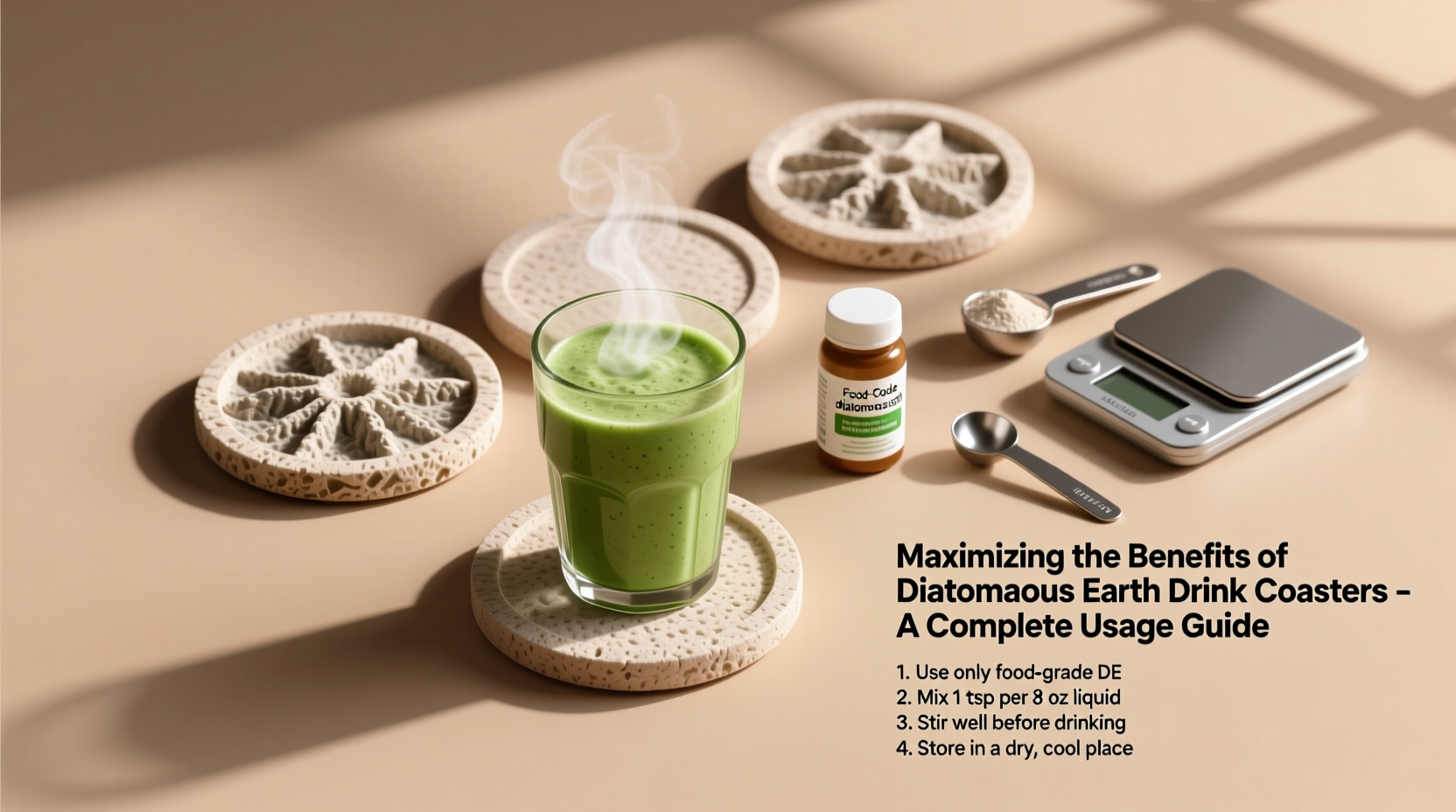Diatomaceous earth (DE) drink coasters have emerged as a sustainable, functional alternative to traditional coasters. Made from fossilized remains of marine phytoplankton, these porous, naturally absorbent coasters offer more than just surface protection—they regulate moisture, resist odors, and even inhibit bacterial growth. Yet many users underutilize their potential, treating them like ordinary accessories rather than performance-enhancing tools for home or hospitality environments. This guide dives into the science, care, and strategic use of DE coasters to help you extract every benefit they offer.
Why Diatomaceous Earth Coasters Are Different

Unlike cork, silicone, or fabric coasters, diatomaceous earth is composed primarily of silica, forming a rigid yet highly porous structure. Each coaster contains millions of microscopic pores that actively wick moisture away from glass surfaces, reducing condensation buildup on tables. This natural capillary action prevents water rings and protects wood finishes without chemical treatments.
The material is also naturally antimicrobial. A 2021 study published in the Journal of Applied Microbiology found that diatomite surfaces reduced surface colonization of common bacteria like E. coli and S. aureus by up to 68% over 24 hours compared to standard ceramic tiles.
“Diatomaceous earth’s physical structure creates an inhospitable environment for microbes—its sharp edges disrupt cell membranes, and its dryness limits replication.” — Dr. Lena Torres, Materials Scientist, University of Oregon
Step-by-Step Guide to Optimal Use
To truly maximize the benefits of your DE coasters, follow this structured routine from initial setup to long-term maintenance.
- Initial Activation: Before first use, rinse each coaster under warm water and let it air-dry completely. This removes residual dust and opens micropores for maximum absorption.
- Placement Strategy: Position coasters in high-moisture areas—near coffee stations, bars, or dining tables. Avoid placing near heat sources like stoves or radiators, which can degrade structural integrity over time.
- Daily Use: Always place glasses directly in the center. The middle zone offers the highest density of active pores. Rotate coasters daily to allow full drying between uses.
- Weekly Refresh: Soak in a mixture of one part white vinegar to three parts water for 30 minutes. Rinse and dry upright to prevent warping.
- Monthly Deep Conditioning: Apply a light mist of food-grade mineral oil to restore surface luster and reduce dust accumulation. Wipe off excess after 10 minutes.
Care and Maintenance Checklist
Consistent upkeep ensures longevity and sustained performance. Follow this checklist monthly:
- ✅ Inspect for cracks or chipping along edges
- ✅ Clean with vinegar solution to remove mineral deposits
- ✅ Allow 24-hour air-dry after cleaning
- ✅ Store in ventilated area when not in seasonal use
- ✅ Reapply mineral oil if surface appears dull or overly porous
Common Mistakes and How to Avoid Them
Even well-intentioned users can shorten the lifespan of their DE coasters through simple oversights. Below is a comparison of best practices versus common errors.
| Do’s | Don’ts |
|---|---|
| Use coasters indoors or under covered patios | Leave outdoors during rain or snow |
| Dry completely between uses | Stack wet coasters immediately after use |
| Clean with mild vinegar or baking soda paste | Scrub with abrasive pads or steel wool |
| Rotate coaster placement weekly | Use same coaster daily without rest |
| Store flat with space between units | Pile in tight containers where moisture traps |
Real-World Application: A Café Case Study
In Portland, OR, “Haven Brew,” a specialty coffee shop, replaced all synthetic coasters with diatomaceous earth models to align with their zero-waste mission. Initially, staff reported faster table turnover due to reduced water marks and less frequent wiping. However, within six weeks, several coasters developed surface cracks.
An audit revealed two issues: employees were stacking damp coasters overnight, and some were being washed in the dishwasher. After implementing a protocol—air-drying upright, hand-cleaning weekly, and rotating stock—the café extended coaster lifespan from 4 months to over 14 months. Customer feedback noted improved table aesthetics and fewer slippery surfaces.
As manager Rafael Chen stated: “Switching wasn’t just about sustainability—it cut our cleaning time by nearly 20%. Now we train new hires on proper DE care as part of onboarding.”
Frequently Asked Questions
Are diatomaceous earth coasters safe for food contact?
Yes. Food-grade diatomaceous earth is non-toxic and approved by the FDA for indirect food contact. These coasters are made from the same classification used in grain storage and organic farming, ensuring safety around beverages and dining areas.
Can I use DE coasters for hot drinks like tea or coffee?
Absolutely. They handle temperatures up to 300°F (149°C) without degradation. However, avoid direct contact with boiling liquids or steam vents, as rapid thermal shifts may cause microfractures over time.
How long do diatomaceous earth coasters last?
With proper care, most last 1–2 years in residential settings and 8–14 months in commercial environments. Signs of end-of-life include persistent staining, crumbling edges, or diminished absorbency despite cleaning.
Maximizing Long-Term Value
The true advantage of DE coasters lies in cumulative benefits: protecting furniture, reducing cleaning labor, minimizing microbial load, and supporting eco-conscious design. To optimize return on investment:
- Pair with matching trays to contain dust and simplify transport
- Label sets by room or function (e.g., “Bar,” “Living Room”) to track wear patterns
- Donate old but intact coasters to community centers or cafes instead of discarding
- Consider purchasing replacement sets in bulk for cost efficiency and consistent sizing
Conclusion: Turn Simple Habits Into Lasting Results
Diatomaceous earth drink coasters are more than decorative accents—they’re engineered tools for better home and hospitality management. By understanding their composition, respecting their limitations, and following a disciplined care routine, you unlock lasting protection, hygiene, and aesthetic consistency. Whether you're a homeowner, host, or business operator, integrating these practices transforms a simple coaster into a functional asset.









 浙公网安备
33010002000092号
浙公网安备
33010002000092号 浙B2-20120091-4
浙B2-20120091-4
Comments
No comments yet. Why don't you start the discussion?